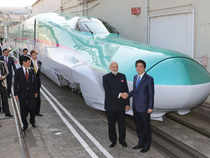On Thursday, India will be a step closer to the bullet train that would help drag the world’s fourth-largest railways into the 21st century.
The much-talked-about project gets off the ground on September 14, with a ceremony near Sabarmati station to be attended by PM Modi and Japanese counterpart Shinzo Abe, whose country is providing the knowhow, and a generous soft loan, of close to Rs 90,000 crore, for the project.
The train, which will start running on August 15, 2022 - when India completes 75 years of independence, promises to reduce travel time between the Mumbai and Ahmedabad to less than three hours from the current seven hours. The train also reduces a pain point for Prime Minister Modi -- jobs.
The train project will create job opportunities for about 20,000 people. Further, some 16,000 indirect employment opportunities are expected to be generated that works well for Modi's 10-million-jobs-a-year election pledge.
A top speed of 350 kmph is not the only thing thrilling about this train. Passengers will also get the thrill of riding under the sea, a first in the country, near Thane at a maximum speed of 350 km per hour. Barring the 21-km-long tunnel, most part of the 508-km-long corridor will be on an elevated track to avoid land acquisitions.
20,000 jobs, undersea tunnel and an opportunity to ace the Rajdhani, the bullet train promises to change India's landscape real fast.These 6 points can help you catch up.
How is it so fast?
It rides on Japanese Shinkansen high speed rail technology. Shinkansen means a 'new trunk line' in Japanese. The first Shinkansen train ran at a maximum speed of 210 km/h. Today, a Shinkansen's maximum speed is 320 km/h. It was the fastest train in the world till 2002 when China ran a maglev train at 431km/h.
Who all will get it?
Apart from the planned Mumbai-Ahmedabad line, the bullet train will touch the following routes -- Delhi-Kolkata, Delhi-Mumbai, Mumbai-Chennai, Delhi-Chandigarh, Mumbai-Nagpur, Delhi- Nagpur. As per reports, 11 stations are proposed in its plan starting from Mumbai to Ahmedabad.
How much will you pay?
The ticket rates of the Rs 1.08 lakh crore project could be higher than those of regular AC trains. A formal rate chart is not out yet, but according to some reports the price of tickets is expected to range between Rs 3,000-5,000.
Is it safe to bank on the train's speed?
Shinkansen trains have never been involved in any accident since 1964. They have an inbuilt safety system even for an eventuality like earthquake. Advanced sensors can detect an earthquake at an early stage and automatically stop the train. It's delay record is less than a minute with zero fatality.
Can we make our own?
That's a possiblity. Indian Railways is exploring a localisation plan which rides on a Make in India clause that can enable chances of making a similar train to export it. "The Japanese funded project allows for transfer of technology," railway minister Piyush Goyal said.
Is it really worth it?
While Modi has described the bullet train project as historic, opposition has questioned the plan, arguing fares will be beyond the reach of many in a country where most people live on less than $3.10 per day. The money could be used on basic needs such as housing for the poor, according to the Congress.
"What you have to crack is the ability to replicate this technology -- to develop the capability in our country to do this in-house," says Rajaji Meshram, a director of infrastructure and government services at KMPG in New Delhi. "We have to start somewhere."

No comments:
Post a Comment